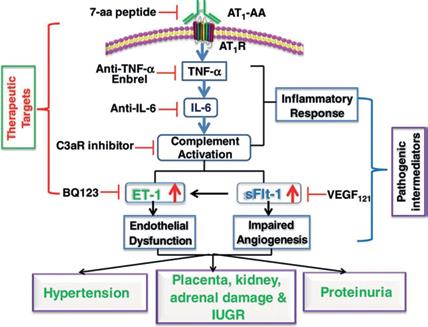
Rodney E. Kellems, PhD
- Professor and Chair
- Bob and Hazel Casey, Endowed Chair
Areas of Interest
Research Interests
Receptor Activating Autoantibodies and Disease
Autoimmune Hypertension: The Role of Receptor-Activating Autoantibodies in Disease
Numerous forms of hypertension have an underlying autoimmune component associated with elevated levels of inflammatory cytokines and the presence of autoantibodies capable of activating the major angiotensin II receptor, AT1R (Xia and Kellems 2013). Although these autoantibodies were originally observed in women with preeclampsia (a serious hypertensive disease of pregnancy), they have now been observed in numerous other hypertensive conditions, including malignant hypertension, refractory hypertension and aldosteronism. I have collaborated extensively with Dr. Yang Xia to understand the pathological consequences of these autoantibodies. We were the first to report that these autoantibodies, termed AT1 AA, cause features of preeclampsia when introduced into pregnant mice. Evidence that AT1-AAs contribute to hypertension in experimental animals is now extensive and compelling. A fascinating feature of these autoantibodies is that they uniformly recognize the same epitope (AFHYESQ) located on the second extracellular loop of AT1Rs. In view of the wide-ranging pathophysiological consequences of these autoantibodies, it is important to understand the molecular mechanisms and immunological conditions that initiate their production. This goal is best achieved with an animal model in which the production of these autoantibodies can be experimentally induced with convenience and reproducibility. We have recently developed a mouse model of cytokine-induced hypertension that fulfills these criteria. Our research has revealed that tissue transglutaminase (TG2), a widely distributed enzyme that modifies glutamine residues of proteins, to be required for AT1-AA production and cytokine-induced hypertension. These are important and novel findings that form the basis of our hypothesis that many forms of hypertension result from an autoimmune condition in which cytokine-mediated induction of TG2 results in the post translational modification of AT1Rs, leading to the creation of a neoantigen that stimulates autoimmune production of AT1-AAs. The results of our research are expected to identify therapeutic peptides that will block the hypertensive actions of AT1-AA. Additional research is expected to highlight the use of TGase inhibitors to block the cytokine-induced production of AT1-AA and reduce hypertension.

Pathogenic mediators of angiotensin II type I receptor (AT1R) agonistic autoantibodies (AT1-AA)–induced preeclampsia in pregnant mice. (From Xia and Kellems 2013)
Selected Publications
Xia Y, Kellems RE. 2013. Angiotensin receptor agonistic autoantibodies and hypertension and hypertension: preeclampsia and beyond. Circ Res. 113(1):78-87.
Liu C, Luo R, Wang W, Parchim NF, Iriyama T, Elliot SE, Daugherty PS, Blackwell SC, Sibai B, Kellems RE, Xia Y. 20115. Elevated transglutaminase activity triggers angiotensin receptor activating autoantibody production and pathophysiology of preeclampsia. J Am Heart Assoc. 4:e002323.
Luo R, Liu C, Elliott SE, Wang W, Parchim N, Iriyama T, Daugherty PS, Tao L, Eltzschig HK, Blackwell SC, Sibai BM, Kellems RE and Xia Y. 2016. Transglutaminase is a critical link between inflammation and hypertension. J Am Heart Assoc. 5:e003730.
Liu C, Kellems RE, Xia Y. 2017. Inflammation, Autoimmunity, and Hypertension: The Essential Role of Tissue Transglutaminase. Am J Hypertens. 30:756-764.
Biography
Dr. Kellems received the PhD degree in 1974 from Princeton University for research that provided fundamental insight into mechanisms of protein import into mitochondria. His graduate research it continues to be cited on a regular basis nearly 50 years after initial publication. Postdoctoral research at Stanford University employed emerging techniques in molecular genetics to discover gene amplification as a novel mechanism of drug resistance in mammalian cells. These groundbreaking discoveries had major impact in cancer biology and laid the foundation for the discovery of amplified proto-oncogenes in cancer cells. Gene amplification also had major practical impact in biotechnology where the process is the most frequently used method to overproduce proteins of medical importance in mammalian cells.
In 1978, Dr. Kellems accepted a faculty position at Baylor College of Medicine, where he developed a patented gene amplification technology that was licensed by Baxter Healthcare to produce large amounts of Factors VIII and IX to treat hemophilia. While at Baylor he initiated a new research program to understand the metabolic and molecular basis for the severe combined immune deficiency (SCID) in humans that results from a deficiency in the enzyme adenosine deaminase (ADA). For this purpose, his lab successfully devised a novel two-stage genetic engineering strategy to construct a mouse model of ADA-deficiency. In 1997 Dr. Kellems moved to McGovern Medical School to Chair the Department of Biochemistry and Molecular Biology. While at McGovern Medical School his lab continued research on ADA-deficiency and showed that, in addition to the expected SCID phenotype, the mice displayed numerous other phenotypes resulting from their enzyme deficiency. His lab and others have successfully used these mice as a discovery platform to determine the detrimental role of chronic excessive adenosine signaling in other disease conditions, including lung fibrosis, priapism, pain, hearing loss, renal disease, and wound healing. Additionally, in collaboration with others, ADA-deficient mice were used in pre-clinical tests to show that gene replacement therapy could be successfully used to treat ADA-deficiency. The clinical trials with ADA-deficient children that followed were among the first, and remain the best, examples of successful gene therapy to treat a human genetic disorder.
For the past fifteen years Dr. Kellems has collaborated with Professor Yang Xia to study the role of pathogenic autoantibodies in preeclampsia, a serious hypertensive condition of pregnancy. They showed that women with preeclampsia harbor autoantibodies that activate the major angiotensin receptor and that these autoantibodies cause preeclampsia when injected into pregnant mice. Their research experience prompted them to formulate a working hypothesis that many forms of hypertension result from receptor activating autoantibodies, a condition they termed autoimmune hypertension. Their research shows that the production of these autoantibodies is induced by inflammatory cytokines in a process that requires, transglutaminase-2 (TG2), a ubiquitous enzyme that catalyzes the posttranslational modification of glutamine residues on proteins. These studies have revealed the essential role of TG2 in inflammation, autoimmunity and hypertension.
Dr. Kellems has received over 35 years of support from the National Institutes of Health, co-authored more than 160 papers and has been awarded three U.S. patents. His published work has been cited more than 13,000 times.
Education and Training
AB
Biology, Bellarmine University
PhD
Biochemical Sciences, Princeton University
Postdoctoral Fellow
Molecular Genetics, Stanford University
Graduate Program Affiliations
Molecular and Translational Biology